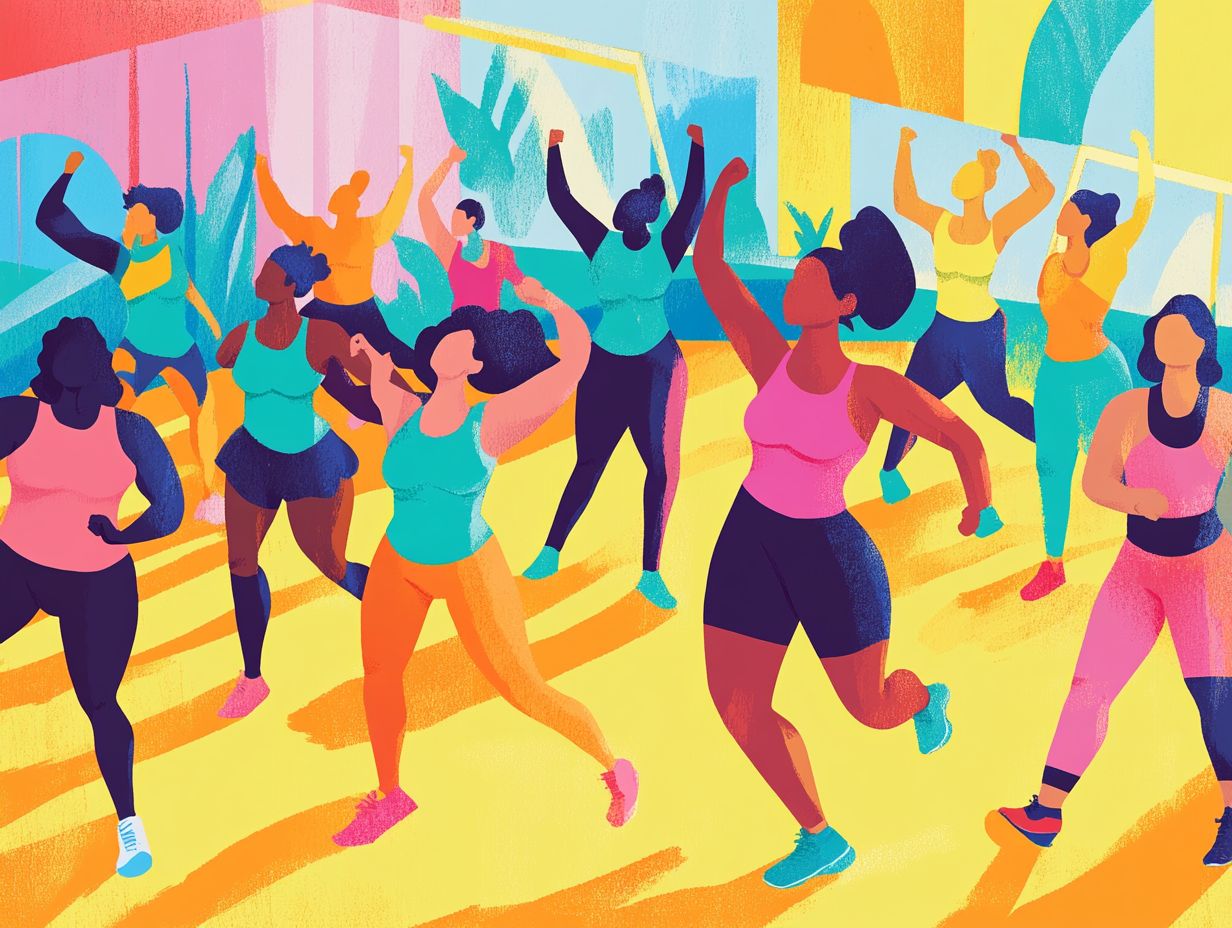Women have distinct physical and emotional needs that must be recognized in the modern fitness landscape to achieve optimal health and wellness. This article explores the reasons for tailoring exercise programs specifically for women, highlighting common pitfalls to avoid and offering guidance on creating a personalized fitness regimen that aligns with individual goals.
Additionally, it examines the most effective types of exercises for targeting specific areas and emphasizes the importance of nutrition and self-care in enhancing overall fitness.
The Importance of Tailoring Exercise for Women

Exercise programs for women are designed to meet their specific fitness needs and goals, which are influenced by their unique biological, hormonal, and social circumstances. Engaging in regular physical activity can enhance women’s health by increasing physical fitness, improving mental resilience, and fostering a positive body image.
These programs can focus on strength training, flexibility, and weight reduction, while also offering community support and enablement to women.
Understanding Women’s Unique Fitness Needs
Women have unique fitness needs that are influenced by hormonal balance, body composition, and mental health. Understanding these factors is essential for designing exercise routines that effectively meet women’s requirements.
Hormonal Balance: Hormonal fluctuations that occur during menstruation, pregnancy, and menopause can affect energy levels, recovery, and overall performance.
Body Composition: Women typically have a different body composition compared to men, characterized by higher body fat and lower muscle mass. This difference impacts their caloric needs and the recovery process after exercise.
Psychological Factors: Elements such as stress, self-esteem, and motivation significantly affect women’s adherence to exercise programs.
Recognizing these factors allows fitness professionals to create exercise programs that consider not only physical capabilities but also the mental aspects of women’s health. For instance, strength training can aid in maintaining muscle mass and bone density while also promoting a positive body image, which can enhance adherence to fitness routines. By focusing on these multifaceted health needs, women can achieve a more balanced state of health.
Common Exercise Mistakes for Women

Common exercise mistakes made by women can hinder their progress and lead to injuries. Being aware of these errors is essential for preventing injuries and ensuring proper adherence to exercise and workout regimens.
Avoiding Injury and Maximizing Results
Women can minimize injuries and maximize results by paying careful attention to their form, listening to their bodies, and incorporating recovery techniques into their fitness routines.
Integrating strength training enhances muscle stability and supports joint health, which helps reduce the likelihood of injuries over time. Flexibility training, such as yoga or dynamic stretching, improves the range of motion, an essential prerequisite for safely executing movements.
Personalized coaching can further enhance safety by providing a framework for customizing workouts to meet individual needs and ensuring that exercises are performed at the appropriate intensity level. Consulting with a physical therapist or a certified fitness trainer to assess physical capabilities can facilitate the development of a personalized plan that promotes progress while minimizing the risk of overuse or injury.
By combining these strategies, women can create a balanced approach to fitness that aligns with their personal goals.
Designing a Customized Exercise Plan

Creating a personalized exercise plan for women is essential to address their unique fitness goals, preferences, and lifestyle constraints. Such a plan takes into account factors such as available time, motivation levels, and specific fitness objectives for each individual.
This tailored approach enables women to more effectively adhere to their health and fitness goals.
Factors to Consider for Personalized Fitness
Factors to Consider When Creating a Personalized Fitness Plan

- Individual Fitness LevelsUnderstanding individual fitness levels is crucial in developing a personalized fitness plan. Each person’s starting point will influence the structure and intensity of the program.
- Body ImageBody image plays a significant role in motivation and commitment. A fitness plan should reflect personal aspirations and foster a positive perception of physical capabilities.
- Motivational StrategiesImplementing motivational strategies is essential to keep women engaged and inspired throughout their fitness journeys. These strategies can include setting achievable milestones, tracking progress, and celebrating successes.
- Personal Fitness GoalsPersonal fitness goals are influenced by previous experiences, such as past workout routines and injuries. Recognizing these factors can help tailor a plan that aligns with an individual’s history and aspirations.
- Body CompositionBody composition is another important consideration when creating a personalized fitness plan. Understanding women’s unique physical makeups, including specific needs, aids in selecting exercises that effectively target the appropriate muscle groups and achieve desired outcomes.
- The Importance of CommunityWomen are more likely to succeed in reaching their fitness goals when they are part of a supportive community. Connecting with others who share similar aspirations fosters encouragement and accountability. This community can exist in physical spaces like gyms, spas, and studios, as well as online forums, groups, and social media platforms, offering both local and global support.
- Fitness AssessmentsFitness assessments are vital for establishing the starting point of each individual’s fitness journey. A comprehensive evaluation identifies strengths and weaknesses, informing the programming that supports development. Women’s fitness assessments should encompass health screenings, anthropometric measurements, body composition evaluations, physical fitness tests, and health-related quality of life questionnaires. While some information can be self-reported, having a healthcare professional conduct these assessments provides a reliable baseline for future evaluations and adjustments. The assessment can also serve as an initial source of motivation and can be repeated regularly to track progress.
- Assessment of Risk FactorsEvaluating risk factors, such as age, sex, weight, and genetics, helps determine susceptibility to certain diseases. This information is essential in creating an effective fitness plan.
- Setting Personal Goals and PreferencesEstablishing personal fitness goals is imperative for success. It is important to consider the reasons behind a woman’s desire to improve her health. Lifestyle factors, such as sedentary versus active jobs, significantly influence the most suitable fitness goals. Goals may vary but typically include categories such as weight management, stress management, complementary activities for other sports, recovery from injury or surgery, and enjoyment and recreation. Additionally, personal preferences regarding exercise types, workout locations, and preferred workout times should be incorporated into the plan.
- Support from Peers and FamilySupport from peers and family is crucial in shaping a woman’s fitness journey. Encouragement from loved ones can significantly enhance motivation and adherence to the fitness plan.
- Personal CircumstancesLastly, personal circumstances must be taken into account when creating a personalized fitness plan. Factors such as busy schedules, childcare responsibilities, and work commitments often dictate the time available for fitness. Therefore, women’s fitness plans should be adaptable to accommodate these challenges.
Best Types of Exercise for Women
The most beneficial types of exercise for women include strength training, cardiovascular training, and flexibility training, each offering its own distinct health benefits.
Targeting Specific Areas and Goals
Exercise routines for women are specifically designed to target certain areas to help them achieve their goals, whether it’s improved muscle tone, enhanced endurance, or better overall body composition.
For instance, weight training exercises such as squats and lunges enhance lower body muscle tone, resulting in stronger thigh and glute muscles. Additionally, high-intensity interval training (HIIT) boosts cardiovascular endurance and increases metabolism, making it an effective method for overall fat loss.
Core strengthening exercises like planks and Russian twists are essential for improving posture and reducing the risk of injury. By concentrating on these specific areas in their exercise routines, women can effectively reach their fitness goals.
Incorporating Nutrition and Self-Care
Proper nutrition and self-care practices are essential for women’s fitness, as they promote overall wellness and help ensure that women maintain adequate energy levels during exercise. This, in turn, allows them to reap the maximum health benefits from their physical activity.
The Role of Diet and Rest in Women’s Fitness
Diet and rest play a crucial role in women’s fitness, as they significantly influence energy levels, performance, and overall wellness. Achieving a balance between these two elements is essential for maximizing results and maintaining long-term health.
Proper nutrition supplies the energy needed for training, enabling women to optimize their workouts, while adequate rest is necessary for muscle recovery and hormonal regulation.
To effectively integrate these aspects into an active lifestyle, women should include a wide variety of nutrient-rich foods in their diet and schedule regular days of rest or light activity. Staying hydrated and monitoring sleep patterns can enhance recovery and help women feel more energized and motivated to pursue their fitness goals.
